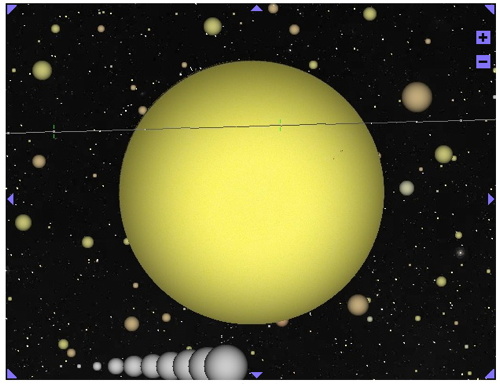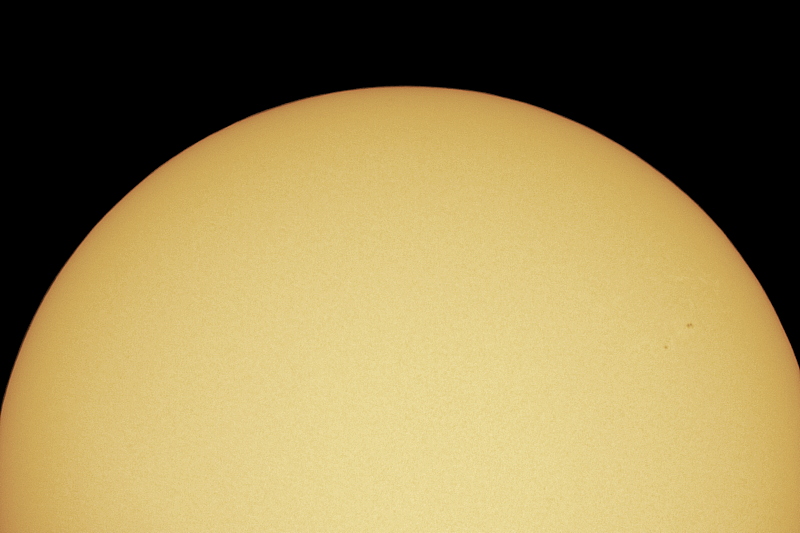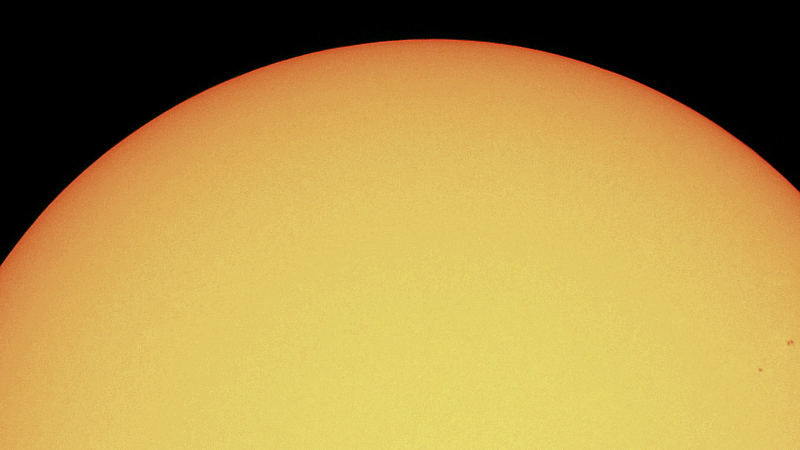HST-Sun Transit (bust);
Observing Stars in Andromeda Galaxy with Meade 12" Telescope
Posted: 21 October 2016
|
Open: Thursday, 20 October 2016, 1313 MST Temperature: 96°F |
Session: 1028 Conditions: Clear, very breezy |
Equipment Used:
12" f/8 LX600 w/StarLock
Wireless AutoStar II handset
2" 24mm UWA eyepiece
Camera:
D7200 DSLR
Opened the observatory to photograph the Hubble Space Telescope (HST) transiting the Sun, per the calculation received from CalSky:

Attached the Thousand Oaks Optical Solar Filter to the 12" telescope. Prepped the D7200 DSLR for prime focus imaging.
1325 MST: LX600 ON, StarLock OFF, High Precision OFF. Did a GOTO the "Sun as Asteroid".
1327 MST: viewed the Sun, 102X. Two small sunspots were visible.
Mounted the D7200 DSLR at prime focus + star diagonal. Took this photo, 1/1600sec, ISO 1600, showing the two small sunspots at the right:

1335 MST: ready for the HST transit. 1348 MST: Began monitoring time signals from radio station WWV on the observatory shortwave radio. SYNCed the observatory clock to WWV.
A few minutes before the transit I did a test HD video recording to confirm all was in readiness. 1401 MST: began a HD video recording, 1.3X crop factor, 60 fps, 1/2500sec, ISO 1000. Recorded the Sun for 1m45s to ensure the transit time (140202 MST) would be covered. Reviewed the video recording after closing the observatory. Unfortunately, the HST was not captured. Seeing was not very good and there were strong breezes blowing, both of which likely influenced the chances of getting the very small, dark, Hubble Space Telescope as it crossed the sun. (I have photographed Chinese Space Station Tiangong-1 and the International Space Station crossing the Sun, as well as the Hubble Space Telescope crossing the Moon. You can see those photos on the Satellites Astrophotography Album.)
This is one frame from the video at the time of the transit showing how the Sun looked:

The next HST-Sun transit visible from Cassiopeia Observatory will be Monday morning, 24 October 2016.
|
Close: Thursday, 20 October 2016, 1413 MST Temperature: 90°F |
Session Length: 1h 00m Conditions: Clear, very breezy |
|
Open: Thursday, 20 October 2016, 2042 MST Temperature: 74°F |
Session: 1029 Conditions: Clear, windy |
Equipment Used:
12" f/8 LX600 w/StarLock
Wireless AutoStar II handset
2" 24mm UWA eyepiece
2" 9mm 100° eyepiece
Camera:
None
2045 MST: LX600 ON, StarLock OFF, High Precision OFF. This would be a short session due to the wind.
2052 MST: slewed to the Andromeda Galaxy (M31). Began trying to observe individual stars in this galaxy, 2.5 million Light-years away from Cassiopeia Observatory. I used a recent blog article at Sky and Telescope for a chart of stars.
First, I located the NGC206 star cloud (which I recently imaged). It was easily seen at 102X (2" 24mm UWA eyepiece). Then switched to 271X (2" 9mm 100° eyepiece) to try for the very faint stars. NGC206 itself was faintly visible at 271X; the best view of the star cloud was using averted vision. Then began comparing the view in the eyepiece to that in the labeled photograph from the article.
I started with the stars marked with the triangle. Two stars were easy: Magnitude +13.1 and +14.8. The third star in the triangle was also easy. As my eye dark adaptation continued I began searching for the fainter stars. I began with the Mag +15.5 star near the bottom of NGC206. Within a few minutes I was able to see it. That was followed by the three close stars: Mag +15.3, +15.7, and intermittently the Mag +16.2 star! I then searched for and saw the two remaining stars, both Mag +16.0. I returned to the triangle area and picked up the Mag +15.8 star there.
Switched back to the 24mm eyepiece (102X). I could easily see the Mag +13.1 and +14.8 stars in the triangle as well as the Mag +15.5 and +15.3 stars at the bottom of NGC206.
This was an exciting experience. To be able to see individual stars in the Andromeda Galaxy was awesome! I have previously viewed the G76 globular cluster in the Andromeda Galaxy with the 8" and 12" telescopes, but it just appeared as a "fuzzy star". The Mag +15 and +16 stars seen this night were obviously single stars in my eyepiece. So cool!
|
Close: Thursday, 20 October 2016, 2140 MST Temperature: 70°F |
Session Length: 0h 58m Conditions: Clear, windy |
Comments are welcome using Email. Twitter users can use the button below to tweet this report to your followers. Thanks.
Cassiopeia Observatory Home Page
Copyright ©2016 Michael L. Weasner / mweasner@me.com
URL = http://www.weasner.com/co/Reports/2016/10/21/index.html
